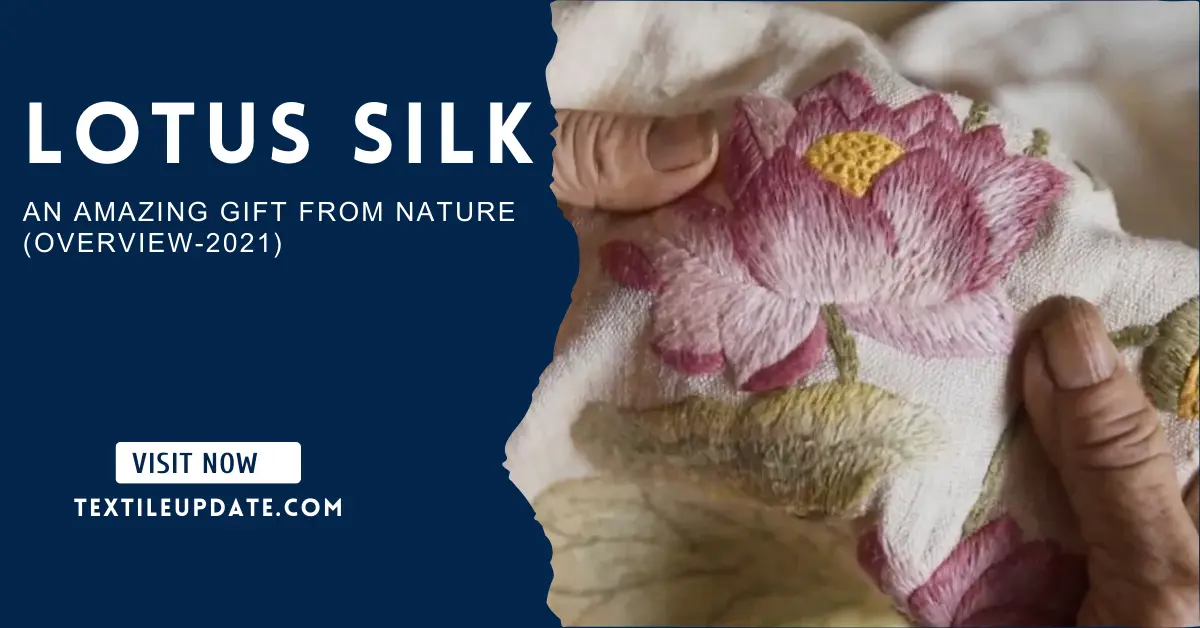Almost everyone is familiar with the word Silk. Silk is made from the silkworm. But many of us may not know that silk can be made from a lotus flower. I was very surprised when I first found out about it. Incredibly it is true that silk is made from lotus. This silk is not ordinary silk but it is known as the most expensive silk in the world. Today’s article is to spread this knowledge among others.
Table of Contents
What is lotus silk?
Lotus silk is a type of textile produced using delicate lotus stem fibers. Lotus silk is a rare and highly exclusive fiber. It is a natural flower fiber because the silk thread comes from the stem of a lotus flower. Therefore this fibre is 100% animal cruelty-free. The lotus fabric is the first natural microfiber and probably the most ecological fabric in the world and it has unique properties. Lotus silk’s exceptional properties are – lightweight, soft-touch, silky hand,
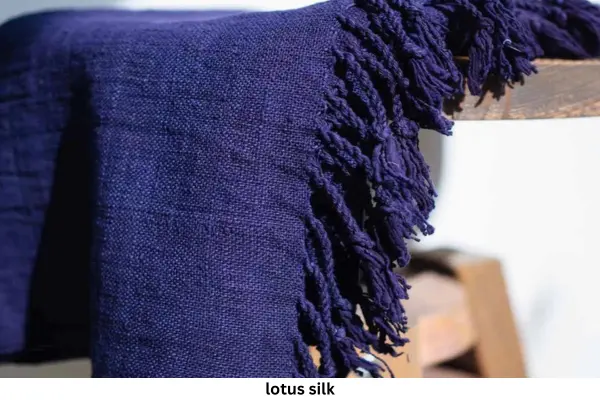
Especially breathable, Wrinkle resistant, Piling resistant, Tearing and tensile strength [According to a test report realized in 2016 by IFTH (the French Textile and Clothing Institute
History of Lotus Silk
The process of collecting fiber from the Lotus branch has been visible since 1910. The first production of this fiber started in Myanmar, Thailand, Cambodia, and more recently Vietnam. Later in the 90’s, Japanese designers set up a workshop and planned to produce lotus fabric there. However, the plan was not implemented in Japan due to low demand.
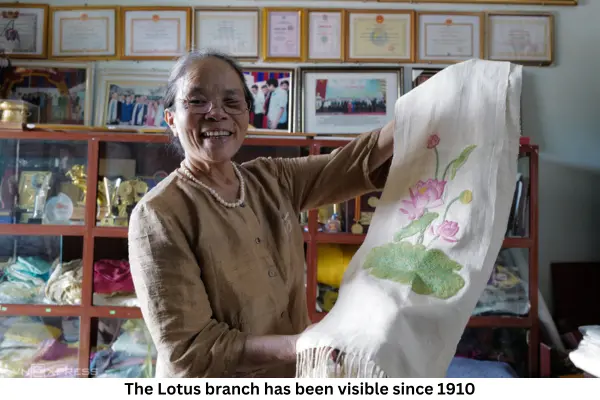
Recently, a woman named Phan Thi Thuan from Vietnam first discovered this lotus silk in her country. While this fabric has been made for years in Myanmar by using the Lotus flower, Phan Thi Thuan only started experimenting with this fiber in 2017. It is good to say that there is a lot of lotus in Vietnam and this flower is the national flower of that country. The locals used to do business with lotus flowers and lotus seeds but they would throw away the lotus stem. One day she went to pick some lotuses and broke some lotus stems.
She saw something like fiber in the broken stem and brought it in for testing. After drying the fibers in a special way and finding something that looked like a thread, she ran a few more experiments with that thread and succeeded. Then she became the inventor of lotus silk by making yarn and silk suitable for weaving cloth from the stem left by lotus.
How is it produced?
The process of collecting yarn from Lotus branches is quite difficult. According to the traditional Burmese and Thai methods, the spinning and weaving process is performed by handwork. Silk is made by collecting the fibers of the lotus branch while it is still soft. And the allocation for this is only 24 hours. Because when the branch dries, the fiber cannot be removed from the branch. At first, many lotus branches are collected. Among them 5-6 branches are cut together. These are separated by 20-30 clean filaments through twisting process.
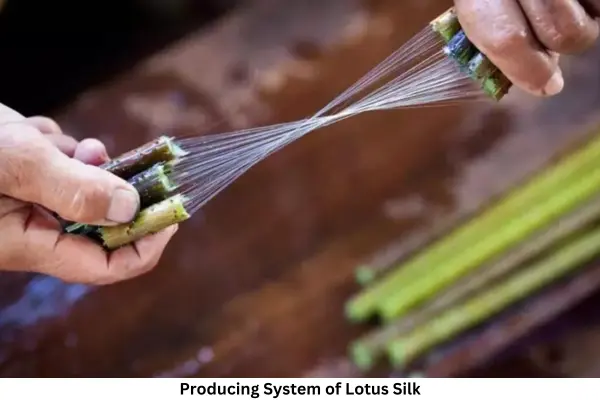
It is then turned into a yarn by drafting and rolling. After the yarn is made, the yarn is placed on a spinning frame made of bamboo. The yarn is then turned into a winder for the warping process. The yarn is stored separately in a plastic bag after making 40 meters of yarn to prevent further tangling. Excess yarn separated from the tangle is preserved and subsequently trimmed during the weaving process. During the weaving process, the yarns are continuously soaked with water to keep the fibers cool.
The width of the fabric is about 24 inches. Here natural dyeing process is followed. Approximately 1 lakh 20 thousand lotus branches are needed to produce the fabric required to make a perfect garment. This whole process is very time-consuming as it is done by hand and the amount of production is also small. Some special care has to be taken for lotus silk. For example, It will not need a lot of washing but if you want to wash you should wash it by hand, do not bleach while washing, It does not need to be ironed, and avoid direct sunlight when drying. For dry-clean only petroleum solvent can be used.
Why is lotus silk so expensive?
Now I give the most astonishing information. By working hand in hand, a skilled worker can make yarn by collecting fiber from 200-250 lotus branches per day! It is possible to weave only 1.75 meters of fabric with yarn made from fiber collected from 9200 branches, with which only 36 cm of a scarf can be made. As such, if we hold 200 branches per person, then it takes 48 workers to extract fiber from 9200 branches. Again, if we calculate 250 branches per person, it takes 37.6 or 36 workers.
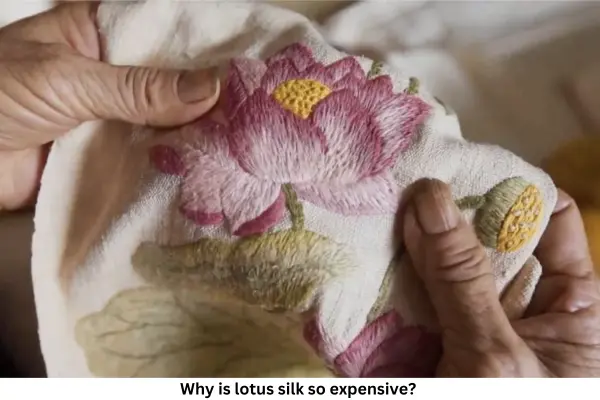
This means that it takes the hard work of 36-46 skilled workers to make only 1.75 meters or 36 cm of a scarf of lotus silk. This is not the end. If one scarf is made by one worker then it takes 2 months per person. Now it comes to price. Only 25 cm of a scarf made of lotus silk will cost 200 $! Think about the hard work behind it before you are surprised to see the price. This is the reason why this difficult lotus silk is still considered the most expensive silk in the world. Eco-friendly fabrics made from this silk are more comfortable than other fabrics and hence the demand is for fashion-conscious people in the developed world.
Impact of lotus silk
Lotus fabric is called the best eco-friendly fabric because it is made from lotus stems and branches. This process turns waste into a quality textile product. No chemicals or toxins are involved in the production process. In the past, Buddhist monks in Myanmar and Thailand used to wear garments made of lotus fabric. In keeping with this tradition, many saints and pious people still wear this fabric. Due to its high cost, only affluent people use it.
In 2012, the “UNESCO Handicrafts Programme ” was held in Southeast Asia, where Lotus fabric garments received the ” Seal of Excellence ” award. The fabric is able to attract the attention of all over the world. Lotus silk is still not popular around the world. There is no pollution in this work. Of course, this is a big aspect. The demand for Lotus Silk is increasing day by day among fashion designers all over the world.
Reference
- https://en.wikipedia.org/wiki/Lotus_silk
- https://www.textiletoday.com.bd/what-makes-lotus-silk-the-rarest-fiber-in-the-world/
- https://youtu.be/QKg0X9CK6wg
You may also like to read:
Smart Textile: A New Begining in the Apparel Sector (textileupdate.com)
